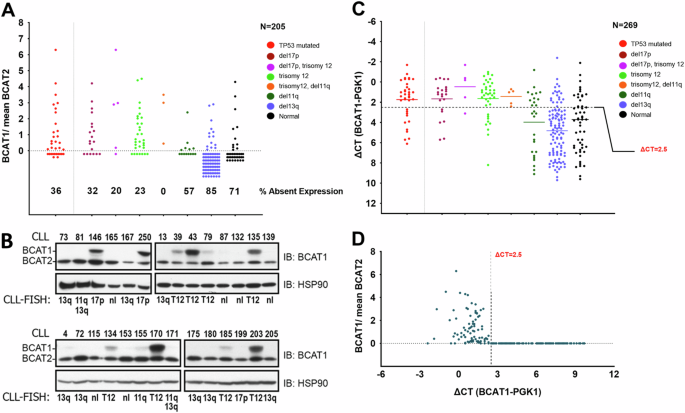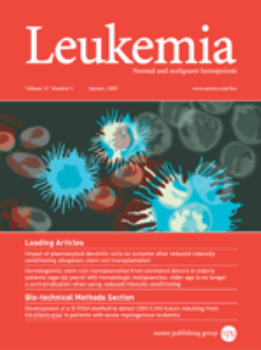Aberrant BCAT1 expression augments MTOR activity and accelerates disease progression in chronic lymphocytic leukemia
IF 12.8
1区 医学
Q1 HEMATOLOGY
引用次数: 0
Abstract
We performed gene expression profiling of mRNA/cDNA isolated from N = 117 flow sorted CLL. We detected aberrant expression of the metabolic enzyme branched chain amino acid transferase (BCAT1) in CLL with del17p/TP53mut. Through extensive validation, we confirmed the highly preferential expression of BCAT1 in CLL with del17p/TP53mut (66%) or trisomy 12 (77%). BCAT1 was not expressed in B cells isolated from normal human lymph nodes. The products of the bidirectional BCAT1 reaction, including leucine, acetyl-CoA, and alpha-ketoglutarate are known activators of MTOR. We measured an ~two-fold higher MTOR activity via normalized p-S6K levels in primary CLL with BCAT1 high versus absent expression before and after sIgM crosslinking. Through steady state metabolomics and heavy isotope metabolic tracing in primary CLL cells, we demonstrate that CLL cells are avid consumers of branched chain amino acids (BCAAs) and that BCAT1 in CLL engages in bidirectional substrate reactions. Of additional interest, CLL with aberrant BCAT1 expression were less sensitive to Venetoclax-induced apoptosis. Biologically, three CLL-derived cell lines with disruption of BCAT1 had substantially reduced growth ex vivo. Clinically, the expression of any detectable BCAT1 protein in CLL independently associated with shorter median survival (125 months versus 296 months; p < 0.0001), even after exclusion of del17p/TP53mut cases.


BCAT1 表达异常会增强 MTOR 活性,加速慢性淋巴细胞白血病的病情发展
我们对从 N = 117 个流式分选 CLL 中分离出的 mRNA/cDNA 进行了基因表达谱分析。我们在 del17p/TP53 突变的 CLL 中检测到代谢酶支链氨基酸转移酶(BCAT1)的异常表达。通过广泛的验证,我们证实了 BCAT1 在有 del17p/TP53 突变(66%)或 12 三体综合征(77%)的 CLL 中高度优先表达。BCAT1在从正常人淋巴结分离的B细胞中没有表达。BCAT1双向反应的产物,包括亮氨酸、乙酰-CoA和α-酮戊二酸,都是已知的MTOR激活剂。在 sIgM 交联前后,我们通过归一化 p-S6K 水平测得 BCAT1 高表达与无表达的原发性 CLL 中 MTOR 活性高出约两倍。通过对原发性 CLL 细胞进行稳态代谢组学研究和重同位素代谢追踪,我们证明 CLL 细胞是支链氨基酸(BCAAs)的狂热消费者,而且 CLL 中的 BCAT1 参与了双向底物反应。更令人感兴趣的是,BCAT1表达异常的CLL对Venetoclax诱导的细胞凋亡不太敏感。从生物学角度来看,三种BCAT1表达异常的CLL衍生细胞系体内外生长能力大大降低。在临床上,即使排除了del17p/TP53突变的病例,CLL中任何可检测到的BCAT1蛋白的表达都与较短的中位生存期(125个月对296个月;p <0.0001)有关。
本文章由计算机程序翻译,如有差异,请以英文原文为准。
求助全文
约1分钟内获得全文
求助全文
来源期刊

Leukemia
医学-血液学
CiteScore
18.10
自引率
3.50%
发文量
270
审稿时长
3-6 weeks
期刊介绍:
Title: Leukemia
Journal Overview:
Publishes high-quality, peer-reviewed research
Covers all aspects of research and treatment of leukemia and allied diseases
Includes studies of normal hemopoiesis due to comparative relevance
Topics of Interest:
Oncogenes
Growth factors
Stem cells
Leukemia genomics
Cell cycle
Signal transduction
Molecular targets for therapy
And more
Content Types:
Original research articles
Reviews
Letters
Correspondence
Comments elaborating on significant advances and covering topical issues
 求助内容:
求助内容: 应助结果提醒方式:
应助结果提醒方式:


